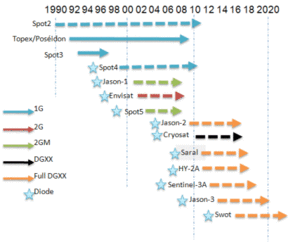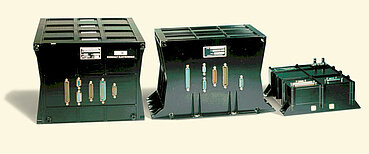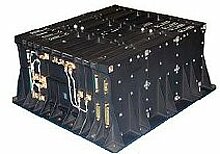A system constantly evolving: precision and miniaturization
The capacity of instruments has been increased with the miniaturization of MVR receivers.
The 2nd generation MVR receivers have two receiving channels against only one channel previously, which increase their accuracy by doing simultaneous measurements on two different ground beacons. Current instruments nammed DGXX improve their autonomy, their robustness against radiations and the system accuracy.
The miniaturization of Doris receivers onboard satellites has been divided by two for Envisat (2nd generation 2G) and four for Jason-1 and Spot5 (2nd generation miniaturized, 2GM).
The DGXX instrument contains only a single case with two receivers and two Ultra Stable Oscillators (USO) and twice seven processing units with dual-frequencies in internal redundancy, the equivalent of 14 instruments of the 1st Doris generation.
The next generation, named DGXX-S, is under development for Sentinel-3 et Jason-3 (and then for Jason-CS et Swot). These instruments will have the same functions as DGXX instruments. A new processor (LEON) will allow new processing capacities on board with benefits on: real time orbit determination (toward centimetric accuracy), Earth pole determination (< 1 mas), beacons frequencey estimation (<10e-12)...
From left to right : 1st generation MVR : Spot 2, 3, 4 and Topex/Poseidon; 2nd generation MVR : Envisat; 2nd miniaturized-generation MVR: Jason-1 and Spot-5 and DGXX: Jason-2
Doris on-board package characteristics
| 1G | 2G | 2GM | DGXX | |
| weight | 19 kg | 12 kg | 6 kg | 18 kg |
| typical power | 20 W | 26 W | 20 W | 23 W |
| dimension | 410x340x210 mm | 340x260x210 mm | 320x270x100 mm | 390x370x165 mm |
| number of channels | 1 | 2 | 2 | 2 x 7 |
Network evolution
On the ground station network, Cnes developed third-generation beacons to improve Doris system accuracy and capacity. The emitted frequencies can now be shifted with respect to the nominal frequencies: ± 50 kHz (2 036.25 MHz) and ± 10 kHz (401.25 MHz). It will thus be easier to avoid jamming by nearby stations.

Further information :
- Newsletter #2, 1993, Doris group calculates orbits to better than 10 cm . F. Nouel.
- Newsletter #5, 1997, Doris sensitivity, P. Exertier et al.
- Doris System Improvements. A. Auriol, IDS Workshop, 2006. (pdf)
- Current trends in the Doris system. A. Auriol, IDS Plenary Meeting, 2004. (pdf)
- A brief overview of Doris system evolutions. P. Sengenes, IDS workshop, 2002. (pdf)
DORIS / Jason-2: less than 10cm centimeters orbits soon available for Near-Real-Time Altimetry. C. Jayles, OST/ST 2008, pdf







